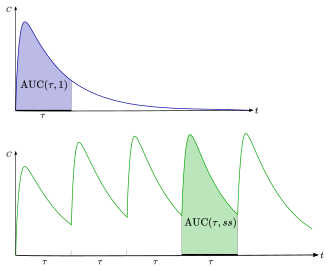Drug accumulation ratio

Drug Accumulation Ratio (DAR) is a pharmacokinetic parameter that indicates the extent to which a drug accumulates in the body after multiple dosing compared to a single dose. It is a crucial factor in understanding the behavior of drugs within the body, especially for those administered over a long period. The DAR can influence both the efficacy and the safety of a medication, making it an essential consideration in drug development and therapeutic drug monitoring.
Definition[edit]
The Drug Accumulation Ratio is defined as the ratio of the drug concentration in the body after multiple doses to the concentration after a single dose. Mathematically, it can be expressed as: \[ \text{DAR} = \frac{\text{C}_{\text{ss,avg}}}{\text{C}_{\text{avg,1}}}, \] where \( \text{C}_{\text{ss,avg}} \) is the average steady-state concentration of the drug after multiple doses, and \( \text{C}_{\text{avg,1}} \) is the average concentration after a single dose.
Factors Influencing Drug Accumulation[edit]
Several factors can affect the accumulation of a drug in the body, including:
- Dosage regimen (dose and frequency)
- Half-life of the drug
- Metabolism and excretion rates
- Drug interactions
- Patient-specific factors such as age, weight, and organ function
Clinical Significance[edit]
Understanding and predicting the DAR is important for several reasons:
- Safety: High accumulation ratios can lead to toxicity, especially for drugs with narrow therapeutic windows.
- Efficacy: Adequate accumulation may be necessary to achieve or maintain the desired therapeutic effect.
- Dosing regimen: Knowledge of DAR helps in designing dosing regimens that balance efficacy and safety, avoiding underdosing or overdosing.
Calculation and Monitoring[edit]
The DAR is typically calculated during the drug development phase using pharmacokinetic modeling and simulations. After a drug is marketed, therapeutic drug monitoring may be employed to assess drug accumulation in individual patients, especially for drugs with high variability or narrow therapeutic indices.
Implications for Drug Development[edit]
During the drug development process, understanding the potential for drug accumulation is critical for determining appropriate dosing regimens. Drugs with a high potential for accumulation may require adjustments in dose or dosing frequency to mitigate risks of toxicity while maintaining therapeutic efficacy.
Conclusion[edit]
The Drug Accumulation Ratio is a key pharmacokinetic parameter that helps clinicians and researchers predict how a drug will behave in the body over time, particularly with repeated dosing. By understanding and managing drug accumulation, healthcare providers can optimize drug therapy for safety and effectiveness, tailoring treatment to the needs of individual patients.
Ad. Transform your life with W8MD's Budget GLP-1 injections from $75


W8MD offers a medical weight loss program to lose weight in Philadelphia. Our physician-supervised medical weight loss provides:
- Weight loss injections in NYC (generic and brand names):
- Zepbound / Mounjaro, Wegovy / Ozempic, Saxenda
- Most insurances accepted or discounted self-pay rates. We will obtain insurance prior authorizations if needed.
- Generic GLP1 weight loss injections from $75 for the starting dose.
- Also offer prescription weight loss medications including Phentermine, Qsymia, Diethylpropion, Contrave etc.
NYC weight loss doctor appointmentsNYC weight loss doctor appointments
Start your NYC weight loss journey today at our NYC medical weight loss and Philadelphia medical weight loss clinics.
- Call 718-946-5500 to lose weight in NYC or for medical weight loss in Philadelphia 215-676-2334.
- Tags:NYC medical weight loss, Philadelphia lose weight Zepbound NYC, Budget GLP1 weight loss injections, Wegovy Philadelphia, Wegovy NYC, Philadelphia medical weight loss, Brookly weight loss and Wegovy NYC
|
WikiMD's Wellness Encyclopedia |
| Let Food Be Thy Medicine Medicine Thy Food - Hippocrates |
Medical Disclaimer: WikiMD is not a substitute for professional medical advice. The information on WikiMD is provided as an information resource only, may be incorrect, outdated or misleading, and is not to be used or relied on for any diagnostic or treatment purposes. Please consult your health care provider before making any healthcare decisions or for guidance about a specific medical condition. WikiMD expressly disclaims responsibility, and shall have no liability, for any damages, loss, injury, or liability whatsoever suffered as a result of your reliance on the information contained in this site. By visiting this site you agree to the foregoing terms and conditions, which may from time to time be changed or supplemented by WikiMD. If you do not agree to the foregoing terms and conditions, you should not enter or use this site. See full disclaimer.
Credits:Most images are courtesy of Wikimedia commons, and templates, categories Wikipedia, licensed under CC BY SA or similar.
Translate this page: - East Asian
中文,
日本,
한국어,
South Asian
हिन्दी,
தமிழ்,
తెలుగు,
Urdu,
ಕನ್ನಡ,
Southeast Asian
Indonesian,
Vietnamese,
Thai,
မြန်မာဘာသာ,
বাংলা
European
español,
Deutsch,
français,
Greek,
português do Brasil,
polski,
română,
русский,
Nederlands,
norsk,
svenska,
suomi,
Italian
Middle Eastern & African
عربى,
Turkish,
Persian,
Hebrew,
Afrikaans,
isiZulu,
Kiswahili,
Other
Bulgarian,
Hungarian,
Czech,
Swedish,
മലയാളം,
मराठी,
ਪੰਜਾਬੀ,
ગુજરાતી,
Portuguese,
Ukrainian
